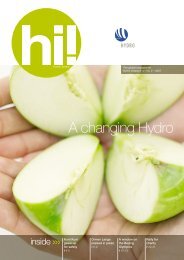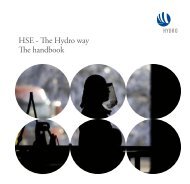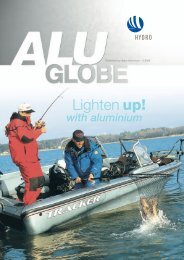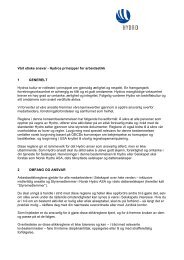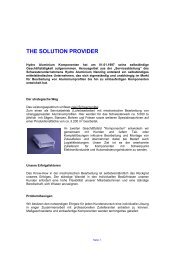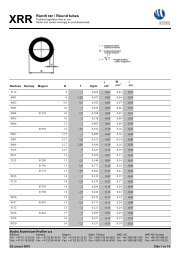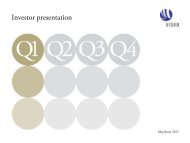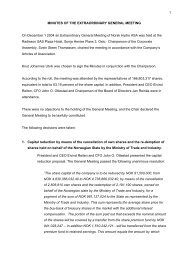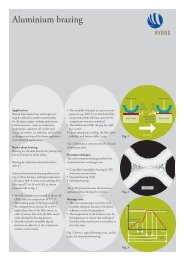Hydro Annual Report 2011b
Hydro Annual Report 2011b
Hydro Annual Report 2011b
You also want an ePaper? Increase the reach of your titles
YUMPU automatically turns print PDFs into web optimized ePapers that Google loves.
FINANCIAL STATEMENTS<br />
Note 1 - Significant accounting policies and reporting entity F13<br />
and cash flow hedges are recognized in the current period's income statement. For fair value hedges, both the changes in the<br />
fair value of the designated derivative instrument and the changes in the fair value of the hedged item are recognized currently<br />
in earnings.<br />
An embedded derivative is bifurcated and accounted for as a separate financial instrument, provided that the economic<br />
characteristics and risks of the embedded derivative are not closely related to those of the host contract, a separate instrument<br />
with the same terms as the embedded derivative would meet the definition of a derivative, and the host contract is not<br />
accounted for at fair value. Embedded derivatives are classified both in the income statement and on the balance sheet based on<br />
the risks in the derivatives' underlying.<br />
Income taxes, current and deferred<br />
Taxes payable is based on taxable profit for the year which excludes items of income or expense that are taxable or deductible in<br />
other years. Taxable profit also excludes items that are never taxable or deductible. <strong>Hydro</strong>'s liability for current tax is calculated<br />
using tax rates that have been enacted or substantively enacted as of the balance sheet date.<br />
Deferred income tax expense is calculated using the liability method in accordance with IAS 12 Income Taxes. Deferred tax<br />
assets and liabilities are classified as non-current in the balance sheet and are measured based on the difference between the<br />
carrying value of assets and liabilities for financial reporting and their tax basis when such differences are considered temporary<br />
in nature. Temporary differences related to intercompany profits are deferred using the buyer's tax rate. Deferred tax assets are<br />
reviewed for recoverability every balance sheet date, and the amount probable of recovery is recognized.<br />
Deferred income tax expense represents the change in deferred tax asset and liability balances during the year except for the<br />
deferred tax related to items recognized in Other comprehensive income or resulting from a business combination or disposal.<br />
Changes resulting from amendments and revisions in tax laws and tax rates are recognized when the new tax laws or rates<br />
become effective or are substantively enacted. Uncertain tax positions are recognized in the financial statements based on<br />
management's expectations.<br />
Deferred tax assets and liabilities are offset when there is a legally enforceable right to set off current tax assets against current<br />
tax liabilities, when they relate to income taxes levied by the same taxation authority, and when the Group intends to settle its<br />
current tax assets and liabilities on a net basis.<br />
Deferred taxes are not provided on undistributed earnings of subsidiaries when the timing of the reversal of this temporary<br />
difference is controlled by <strong>Hydro</strong> and is not expected to happen in the foreseeable future. This is applicable for the majority of<br />
<strong>Hydro</strong>'s subsidiaries.<br />
Share-based compensation<br />
<strong>Hydro</strong> accounts for share-based compensation in accordance with IFRS 2 Share-based Payment. Share-based compensation<br />
expense is measured at fair value over the service period and includes social security taxes that will be paid by <strong>Hydro</strong> at the<br />
settlement date. All changes in fair value are recognized in the income statement.<br />
Employee benefits and post-employment benefits<br />
Payments to employees, such as wages, salaries, social security contributions, paid annual leave, as well as bonus agreements are<br />
accrued in the period in which the associated services are rendered by the employee.<br />
Post-employment benefits are recognized in accordance with IAS 19 Employee Benefits. The cost of providing pension benefits<br />
under a defined benefit plan is determined separately for each plan using the projected unit credit method. Past service costs are<br />
recognized in the income statement on a straight-line basis over the remaining vesting period. Past service cost related to<br />
benefits that are already vested are recognized immediately. Net cumulative actuarial gains and losses in excess of the greater of<br />
10 percent of the benefit obligation (before deducting plan assets) and 10 percent of the fair value of any plan assets are<br />
recognized in the income statement over the remaining service period of active plan participants. When the number of active<br />
plan participants is negligible as compared to the number of inactive plan participants, then the excess cumulative actuarial gain<br />
(loss) is fully recognized at the beginning of the following year. The funded status of a defined benefit pension plan is measured<br />
as of December 31, and disclosed in note 32 Employee retirement plans.



